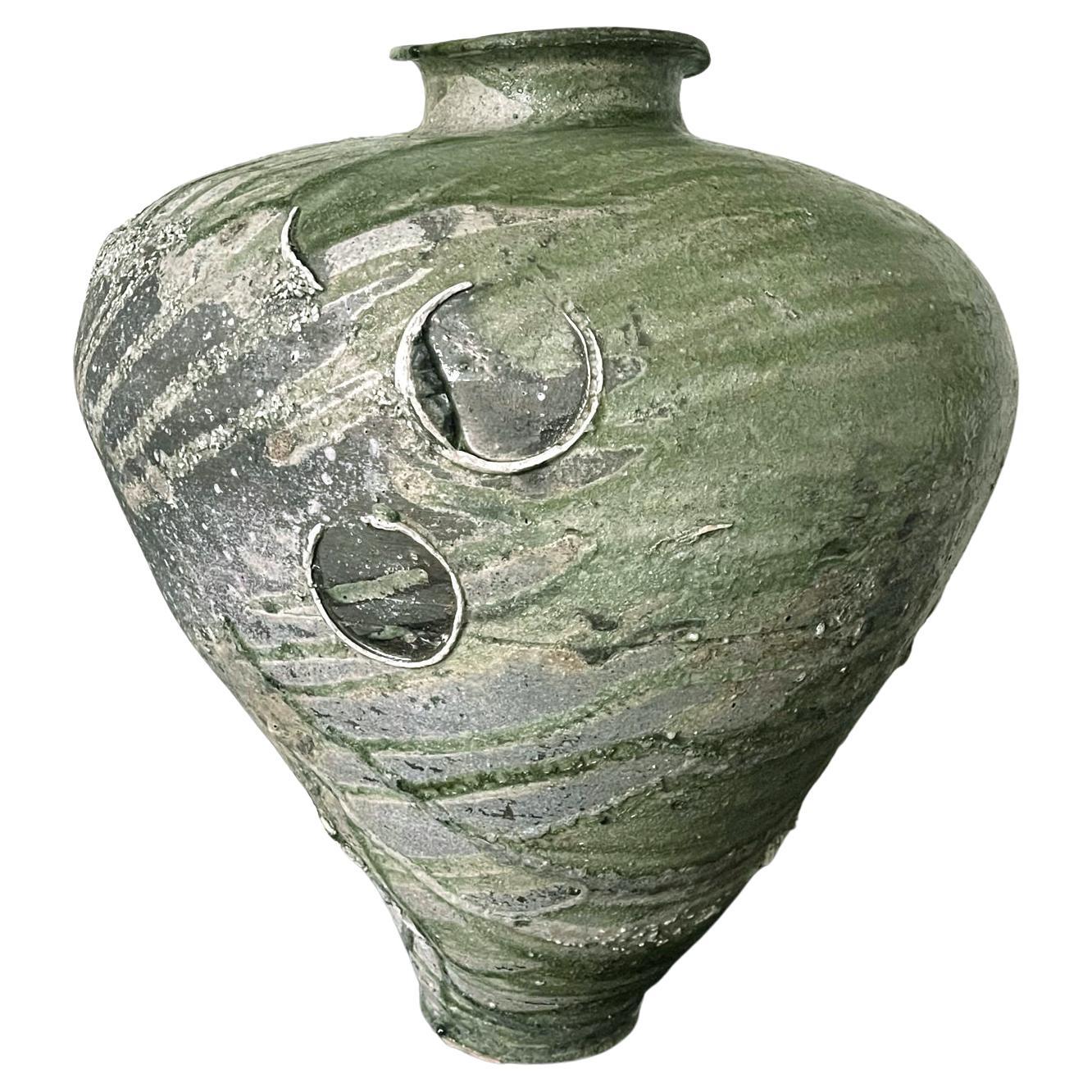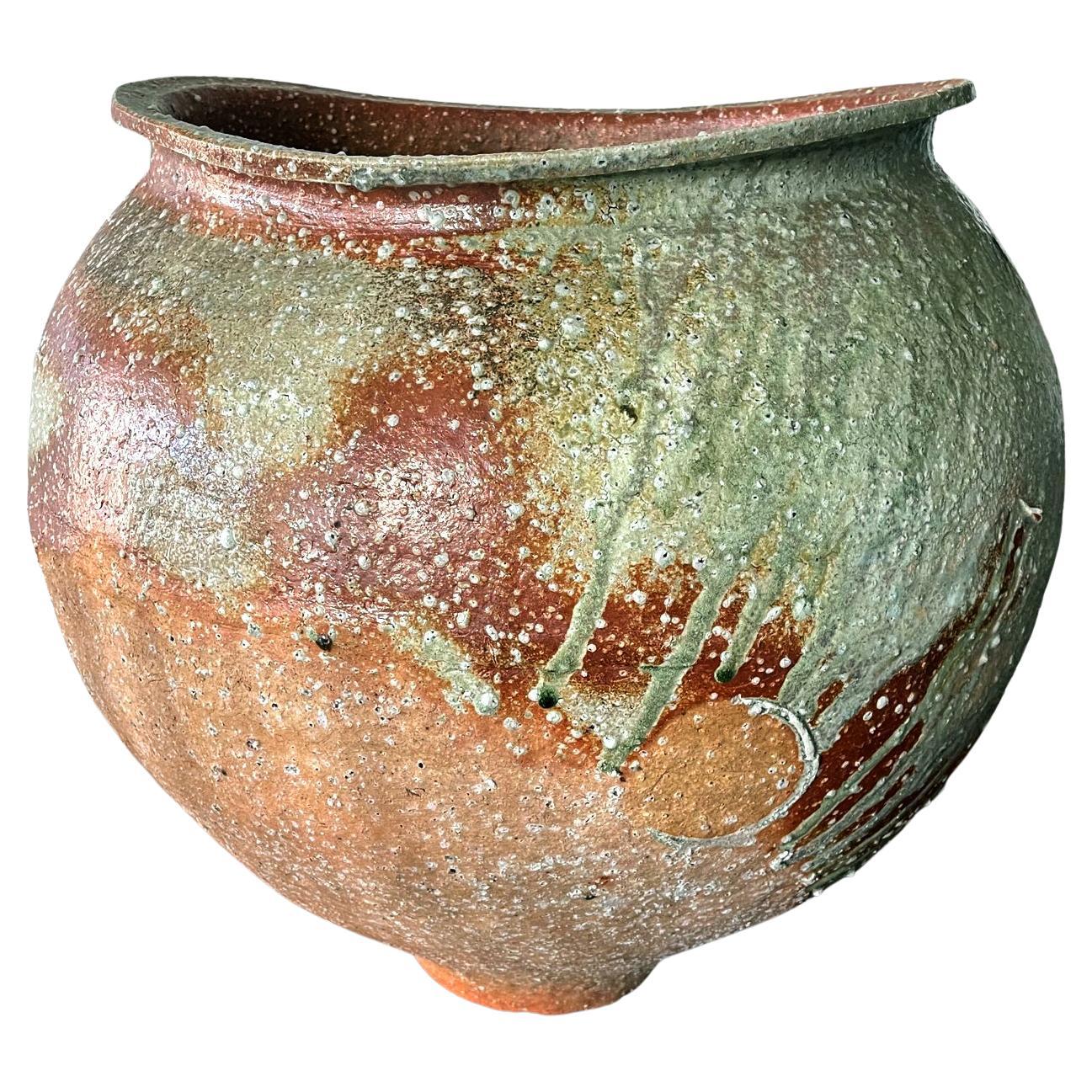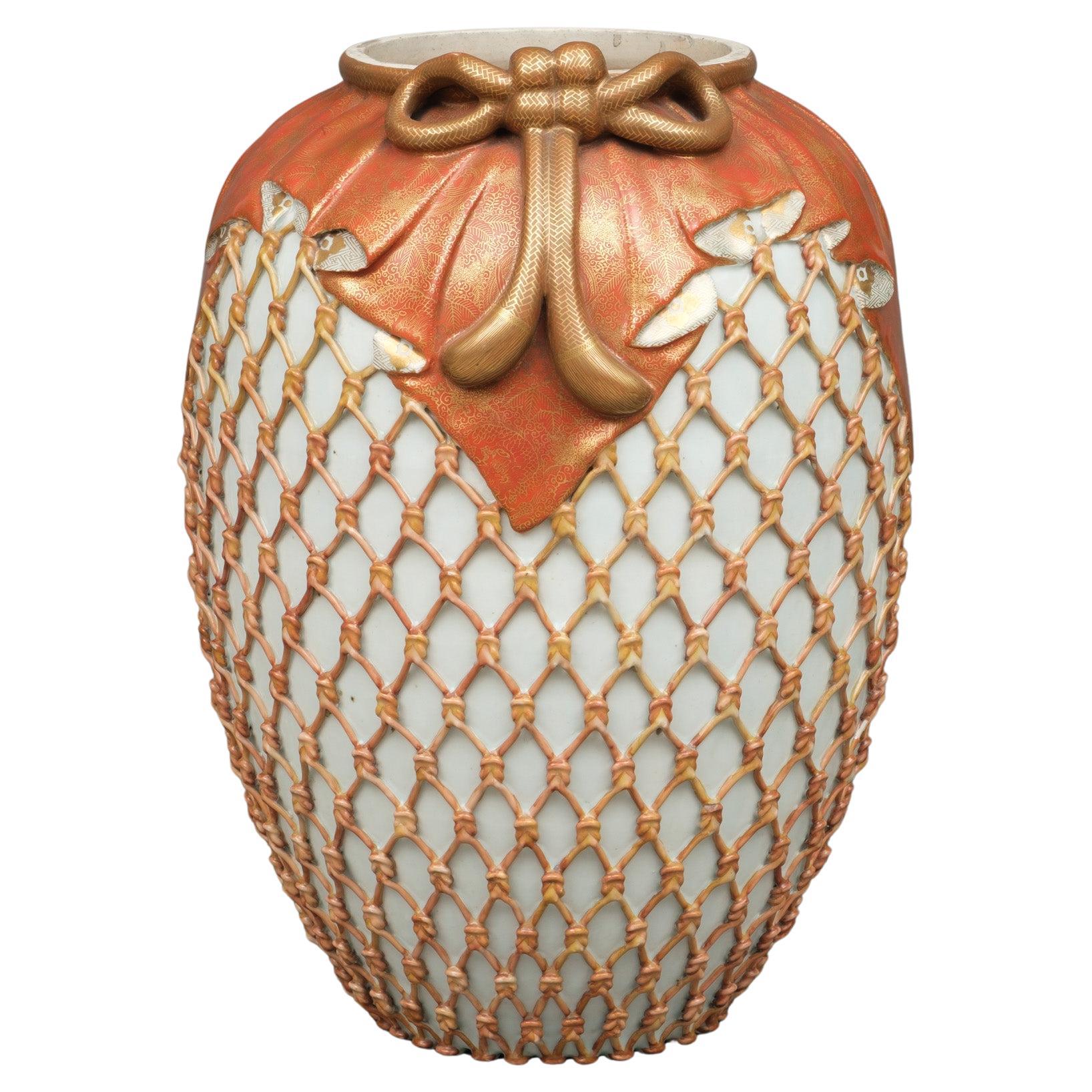Items Similar to Japanese Echizen Ceramic Tsubo Fujita Jurouemon VIII
Want more images or videos?
Request additional images or videos from the seller
1 of 20
Japanese Echizen Ceramic Tsubo Fujita Jurouemon VIII
About the Item
A Japanese storage jar (tsubo) made in the ancient Echizen ware tradition by Fujita Jurouemon VIII. Echizen is one of the six ancient kilns in Japan, directly influenced by the Sue ware of the Heian period. Echizen ware is fired without applied glaze or decoration. Its surface is only marked with the natural ash splashes during the firing process. It is appreciated for its simple and robust form with an archaic appearance and randomly occurred surface texture. Fired at high temperature, Echizen yaki is a form of earthenware between pottery and porcelain, also called yakishime or semi-porcelain.
Fujita Jurouemon VIII (1922-2008) used the most traditional kiln and assumed the family head of the eight generation in 1967.
In 1975, he received Fukui Prefecture Traditional Kogei Excellent Successor Award.
The tsubo jar on offer is of a robust form, hand-built from coils and random ash glaze deposit on the surface. It reveals different view from various side. The base was not cut even, resulting in a slightly tilting form from certain angel as shown. It is marked on one side with a carved cross, the insignia of the artist. It comes with a wood storage box (tomobako) with inscription in Kanji (Echizen, Tsubo, and artist's name and seal). Also a paper label card and a brochure of the artist's info and technique.
- Dimensions:Height: 10.75 in (27.31 cm)Diameter: 11 in (27.94 cm)
- Style:Modern (Of the Period)
- Materials and Techniques:
- Place of Origin:
- Period:
- Date of Manufacture:20th Century
- Condition:Wear consistent with age and use. Base not cut even slightly tilting as made. Tomobako with some expected wear.
- Seller Location:Atlanta, GA
- Reference Number:1stDibs: LU945024688592
About the Seller
5.0
Platinum Seller
These expertly vetted sellers are 1stDibs' most experienced sellers and are rated highest by our customers.
Established in 2006
1stDibs seller since 2010
477 sales on 1stDibs
Typical response time: <1 hour
- ShippingRetrieving quote...Ships From: Atlanta, GA
- Return PolicyA return for this item may be initiated within 2 days of delivery.
More From This SellerView All
- Massive Ceramic Jar Tsubo by Japanese Potter Tsujimura YuiBy Tsujimura YuiLocated in Atlanta, GAA massive and magnificent ceramic Tsubo jar by Japanese potter Tsujimura Yui (1975-). Inspired by the techniques and aesthetics of the early medieval Sue ware, the artist hand builds an impressive voluminous oviform, irregular by intention, from a combination clay from both Shigaraki and Iga, coarse by nature and rich in feldspar. Fired on their sides horizontally, the surface of the thick wall tsubo is covered with streaks and drips of natural ash glazes in shades of green and blue, forming an abstract and mesmerizing pattern that resembles geothermal earth activity. Additional ashes are blown during the firing to accentuate the textures. Most recognizably, there are many circular marks scattered on the surface of his archaic looking vessels. That is resulted from using stacked tea bowls to prevent the conjoining of the vessels. After the firing, the stacked vessels are chipped away, leaving behind those circular impression, as well as deep pools of glaze which gather where they were placed. Born in 1975, Tsujimura Yui is the first son of the contemporary ceramic artist Tsujimura Shiro...Category
Early 2000s Japanese Modern Ceramics
MaterialsCeramic
- Large Japanese Antique Shigaraki Tsubo JarLocated in Atlanta, GAAn antique Japanese stoneware storage jar, known as tsubo from Shigaraki kiln, circa 17th-18th century (early Edo possibly Momoyama period)....Category
Antique 17th Century Japanese Japonisme Ceramics
MaterialsCeramic
- Large Contemporary Ceramic Tsubo Jar by Kai TsujimuraLocated in Atlanta, GAA massive stoneware tsubo floor jar created by Japanese contemporary ceramic artist Kai Tsujimura (1976-). The heavy jar with its impressive volume was made in the tradition of Iga ware with local coarse sandy clay that turned reddish after the firing. It took its shape from heavy medieval storage jars with a wide-open mouth. For a nearly identical form, see an Echizen jar from Heian period (794–1185) in the collection of MET (Accession Number: 1977.261). The surface showcases scattered white crystalized feldspars and a green vitrified ash glaze cascade down the body (known as biidoro in Japanese - after the Portuguese word for glass vidoro). These is a globular shape impressed on the jar. It is a signature practice of the Tsujimura potter family by stacking bowls between the pieces in the kiln during the firing, resulting in an accidental but iconic aethetic (Kai and Yui Tsujimura...Category
2010s Japanese Organic Modern Ceramics
MaterialsStoneware
- Large Ceremic Shigaraki Tsubo by Nagaoka MasamiLocated in Atlanta, GAAn impressive Shigaraki Tsubo (jar normally for storage) in an archaic form with a bulbous and robust body that opens with a small lipped mouth. Heavil...Category
21st Century and Contemporary Japanese Modern Ceramics
MaterialsCeramic
- Japanese Mishima Ceramic Vase Meiji PeriodLocated in Atlanta, GAA Japanese long neck slender ceramic vase in the style of Mishima, circa 19th century, Meiji period. Mishima pottery was originally imported from three islands in Taiwan and then fro...Category
Antique 19th Century Japanese Japonisme Ceramics
MaterialsCeramic
- Large Japanese Satsuma Ceramic Vase KinkozanBy KinkozanLocated in Atlanta, GAA large Japanese ceramic vase from the end of Meiji period circa 1890-1910s by Kinkozan (1645-1927). One of the largest studio manufacturers of the export ceramics at the time based in Kyoto. In the typical style of satsuma made at the turn of 20th century, the vase is elaborately decorated with a rather unusual kinran-de (gold paint) and green enamel highlight on a mottled brown background. The painterly decoration depicts a large seasonal floral arrangement in a circular fashion. Besides the obviously superb craftsmanship, what sets this particular vase apart from many lower quality and mass-produced pieces is its tone-on-tone color pallet that is visually somber and the small and sensitive details that heralds the change of the seasons. When the viewer goes beyond the first casual glimpse of the blossom and foliage, one would notice that on the edges of certain leaves as well as along the stalks, there accumulates a very thin layer of the white dust that represents the frost. The flower in bloom are chrysanthemums. Despite of being splendid, they are the messengers of the autumn. The large lotus leaf was subtly rendered in a bended and slightly withered manner, just past its prime. Although the lotus is still in bloom, the prominent seed pod indicates it may be the last for the season. The sentimental capture of the change of the seasons is not unusual in Japanese art. This vase poetically represents such a subtle transition from summer to fall, perhaps depicting the very first frost. The neck of the vase is also slightly unusual with two rolled rings...Category
Early 20th Century Japanese Meiji Ceramics
MaterialsCeramic
You May Also Like
- Large Japanese Meiji Kyo-Ware Porcelain 'Tsubo' Vase by Kanzan Denshichi 幹山伝七By Kanzan Denshichi 幹山伝七Located in Amsterdam, NLTall and exceptionally made Kyo-ware porcelain jar (tsubo) with a naturalistically relief design of a coral-coloured net stretched around the body. On the shoulder hangs a beautifully draped red...Category
Antique Late 19th Century Japanese Ceramics
MaterialsPorcelain
- Japanese Antique Muromachi Edo Wabi-Sabi Tokoname Art Pottery Jar Tsubo Pot VaseLocated in Studio City, CAAn absolutely stunning Tokoname ware stoneware vase/jar/vessel - produced sometime during the late Muromachi period (1336-1573 to early Edo Period (1603-1867). Tokoname-yaki ware is ...Category
Antique 16th Century Japanese Edo Ceramics
MaterialsPottery, Stoneware
- Japanese Ceramic VaseLocated in Palm Desert, CAVery unique Japanese vase with abstract pattern in a variety of brown tones. The deepest brown glaze is raised, giving the vase a wonderful tactile texture.Category
Late 20th Century Japanese Organic Modern Vases
MaterialsCeramic
- Japanese Ceramic Blue Vases, PairLocated in New York, NYA beautiful pair of Modern periwinkle blue Japanese vases with octagonal base, pinched waist, and clover like design at neck/top. Marked underneath/bot...Category
Early 20th Century Japanese Modern Vases
MaterialsCeramic
- Japanese Antique Edo Wabi-Sabi Tamba Tanba Large Art Pottery Jar Tsubo Pot VaseLocated in Studio City, CAAn absolutely stunning Tamba (Tanba) ware Japanese pottery vase/jar/pot - produced sometime during the Edo Period (1603-1867). Tamba-yaki ware is a type of Japanese pottery and ceram...Category
Antique 18th Century Japanese Edo Ceramics
MaterialsPottery
- Japanese Antique Edo Wabi-Sabi Bizen Ware Large Art Pottery Jar Tsubo Pot VaseLocated in Studio City, CAAn absolutely stunning Bizen ware stoneware vase/tsubo jar/vessel - produced sometime during the mid to late Edo period (1603-1867). Bizen yaki ware is a ty...Category
Antique Mid-19th Century Japanese Edo Ceramics
MaterialsPottery, Stoneware
Recently Viewed
View AllMore Ways To Browse
Carved Cross
Ceramic Japan
Simple Japanese
Japanes Storage
Ceramics From Japan
Japanese 20th Century Modern Furniture
Japanese Head
Japanese Glazed Ceramic
Natural Wood Japanese
Made In Japan Ceramics
Japanese Modern Ceramics
Japanese Influence Furniture
Modern Japan Ceramic
Ancient Japanese Furniture
Traditional Vintage Japanese Art
Japan Made Ceramic
Vintage Japanese Carved
Japanese Seal





